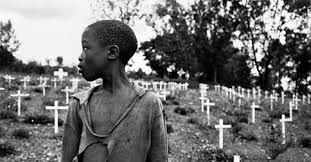Rwanda
In 1994, 800,000 men, women, and children were murdered, mostly Tutsi and some moderate Hutu, by the Interim Government of Rwanda, Rwandan Armed Forces, The Presidential Republican Guard, and Interahamwe (Hutu militias). Flying back from a peace conference in Tanzania, Rwandan President Habyarimana and President Ntaryamira of Burundi, both Hutus, were shot down over Kigali on April 6, 1994. Hutu Power extremists immediately launched the genocide to destroy the entire Tutsi population under the cover of Rwandan civil war. The genocide was led by a Hutu Power clique known as the Akazu, which came from top levels of the Rwandan government. They trained and armed militias and incited genocide months in advance.
Historical Background:
Rwanda’s population in 1994 consisted of 85% Hutu, 14% Tutsi, and 1% Twa. Hutus and Tutsis shared a common language and culture. Most were Roman Catholics. There had been many inter-marriages, but a person’s “ethnic” identity was determined solely by his or her father’s ethnicity. German and Belgian colonizers favored Tutsis in government employment, education, the church, and business, which resulted in Hutu resentment. Belgians introduced identification cards noting ethnic identity in 1933. Ethnicity was kept on ID cards after independence in 1959.
In 1959, Hutus overthrew the Tutsi monarchy and began massacres of Tutsis. Tens of thousands of Tutsis fled to neighboring countries such as Uganda and Burundi. Tutsi refugees formed the Rwandan Patriotic Front (RPF) in 1987.
In 1990, the RPF invaded Rwanda with a force of 7,000 fighters from Uganda and a civil war began. Tutsis in Rwanda were suspected of being accomplices of the RPF. Hutu opposition parties to the President’s MRND were labeled traitors by the Rwandan government. Hutu hate radio and newspapers incited genocide.
A ceasefire to the civil war was signed in 1993 in Arusha, Tanzania. The United Nations sent a peacekeeping force (UNIMIR) to monitor implementation of the Arusha Accords. However, the UN Security Council refused to provide adequate numbers of well-armed troops to enforce it.
The Interim Government, Prefects, Mayors, Rwandan Armed Forces, and Gendarmes organized systematic genocide, but most of the killing was done by Hutu militias, the Interahamwe. Ordinary people, including shopkeepers, teachers, priests, and farmers were encouraged to join the genocide. The killers often knew their victims personally. It is estimated that 200,000 people participated in the perpetration of the genocide. During approximately 100 days until mid-July, 1994, 800,000 people were killed. The genocide and civil war finished simultaneously when the RPF took military control of the entire territory of Rwanda.
In Resolutions 955 (1994) and 978, The United Nations Security Council created the International Criminal Tribunal for Rwanda to try top leaders of the genocide. Over 50 have been tried and over thirty have been convicted of genocide. 100,000 local “gaçaça” trials have been held, usually followed by community service. Rwanda is now in the midst of a lengthy process of reconciliation.
Tensions between Hutu deniers and Tutsis who continue to lead Rwanda have not yet fully healed the schisms underlying Rwanda’s post-genocidal recovery. The Rwandan government has launched a positive educational program to overcome many years of division. Rwanda has returned to rapid economic growth, religious freedom, and improvement in health.
"80% of young people have never heard of the genocide in Rwanda. We want to change that. This film was produced by pupils of St John's School as part of our school's role as an IOE Beacon School in Holocaust education. If your school might be interested in becoming a Beacon School please visit www.ioe.ac.uk/holocaust for details"
Read more
A Look Back At The Trial That Made Rape A War Crime By Melissa Jeltsen, Huffington Post July 29, 2014 The task was almost unimaginable in its magnitude. After the Rwandan genocide, in which an estimated 800,000 people were slaughtered over a hundred days in 1994, the U.N. created the International Criminal Tribunal for Rwanda with the goal of bringing the organizers of the bloodshed to justice. The tribunal's inaugural case, led by two young U.S.
Read more
Rwanda 20 Years Later By Jacqueline Murekatete, Women’s Media Center 2 July 2014 About three years ago, I returned to Rwanda for the first time since the 1994 genocide. Upon returning to the village where I grew up, I was both saddened and angry as I realized there was no sign my family ever lived there. Yams and cassava were growing in the same spot where my family’s home once stood. Horrific memories came flooding back. From April to July
Read more
A Reversal by a Militia of Rwandan Hutus in Democratic Republic of Congo By Somini Sengupta The New York Times 28 June 2014 KIGOGO, Democratic Republic of Congo — Shortly after midday in this village nestled in clouds, the progenitors of the long, dirty war across Central Africa came out of the jungle and laid down their guns. Not all the gunmen in their ranks: 83 guerrillas were present, along with their wives and children. And not all their guns:
Read more
Sharing stories of Rwandan genocide By Anthony O’Reilly, The Island Now June 26, 2014 In a small room in Rwanda, the bodies of genocide victims lay preserved in the exact way they were slaughtered 20 years ago. Jerry Sloane, the treasurer of the Holocaust Memorial and Tolerance Center of Nassau County, said that when he visited Rwanda in 2012 the “smell of death still permeated throughout the room.” “There were women and children with
Read more
Rwanda: French Youth Honour Murambi Genocide Victims BY JEAN PIERRE BUCYENSENGE, All Africa June 26, 2014 A VISITING DELEGATION of young French leaders and their European colleagues has reiterated the need for the truth about France's involvement and the role played by some French leaders in the 1994 Genocide against the Tutsi. The youth, who are on a weeklong visit, were speaking yesterday after touring Murambi memorial site in Nyamagabe District.
Read more
By David Brooke The New York Times 19 June, 2014 Just over two decades ago, Rwanda was swept up in a murderous wave of ethnic violence that was as bad or worse as anything happening today in Iraq and Syria. The conflict was between a historically dominant ethnic minority and a historically oppressed majority, as in Iraq. Yet, today, Rwanda is a relatively successful country. Economic growth has been hovering at about 8 percent a year for the past
Read more
Country Profile: Rwanda - A Country Still Recovering From Genocide By Genocide Watch 23 June, 2014 The Rwandan Genocide in 1994 killed 800,000 Rwandans in 100 days- Africa’s fastest, pre-meditated and systematically implemented genocide. The genocide was aimed at destruction of the Tutsi ethnic group by a fanatical group of Hutu Power leaders, who convinced at least 100,000 other Hutus to participate in the mass murders. Moderate Hutu leaders
Read more
By Eric Reeves 12 June 2014 www.sudanreeves.org Last week the New York Times reported (June 3, 2014) on a significant trove of UN diplomatic cables sent before and during the Rwandan genocide of 1994, and recently declassified. All are marked “confidential” and are extraordinarily revealing of the thinking at the time by many Security Council members, and particularly the Clinton administration’s Permanent Representative to the UN, Madeleine
Read more
Bringing Women to the Table to Address Sexual Violence By Mary Robinson, The New York Times June 11, 2014 In war zones, rape is a weapon. We cannot claim to be serious about stopping war crimes if we do nothing to prevent and punish these heinous acts – and if women are not part of the solution every step of the way. Thanks to the rallying efforts of William Hague and Angelina Jolie, dozens of foreign ministers and legions of advocacy groups are
Read more































































